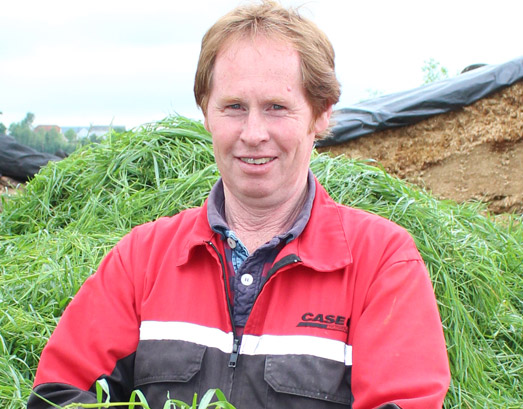Colin Trim
Dairy Farmer
- 280 Holsteins averaging 10,000 litres
- Concentrate usage for high yielders initially reduced from 12kg to 9kg, and cut out all together for low yielders, saving 2 pence/litre
- 80 acres less silage harvested, saving £60/acre harvesting cost, which more than covers the annual cost of the Grazer
- 40 acres of grassland released and put into whole crop, previously grown on rented land
- Potential for further savings in the future by changing feed system
Cost saving Grazer
For Dorset dairy farmer Colin Trim, zero grazing has enabled him to counter some of the effects of the low milk price and improve grassland efficiency on his wet soils.
A year-on from buying his Grass Tech Grazer 120B, he has seen his production costs reduced, thanks to savings in both concentrate usage and contractor charges for silage, and is now looking at how he can adapt his system to further reduce costs.
“For us the key reason for changing from a silage based summer diet to zero grazing was to reduce costs,” states Colin who, with his son Darren, runs a 280 cow Holstein herd at Stour Provost near Gillingham. “For every acre that we zero graze, that’s one less acre that needs to be harvested for silage by a contractor at a cost of about £60 per acre.”
“This saving alone more than covers the annual cost of the Grazer, plus we are currently saving at least 2 pence per litre from a reduction in concentrate use and we are making better use of our grassland. Our soils are wet, but this spring we started zero grazing in the first week of March, when we would never have been able to turn out cows, and we will keep going ‘till late October or November.”
“Because of zero grazing, last year we made 32ha less silage, which has released 16ha of ground that has now gone into whole crop, which we previously grew on rented land. Also, unlike grazing, we have complete control over forage intake.”
The herd, which yields 10,000 litres with butterfat at 4.0% and protein at 3.4%, is milked three times a day and split into a high yielding group, which is housed all-year round while in milk, and a lower yielding late lactation group that mainly graze but are kept in between the second and third milkings.
Prior to zero grazing, the high yielding group was fed a grass silage-based TMR ration that included maize, whole crop and 12kg of a home mixed soya-based blend. With zero grazing, due to the feed barriers in the cubicle house, the fresh grass has to be fed out using the TMR mixer, and the cows get a ration of 30kg of fresh grass, with maize, whole crop and 9kg of blend. The late lactation group also now receive a fresh grass/maize/whole crop ration, but with no blend at all, which previously would have been added. Nothing at all is fed in the parlour.
Going forward, Colin is now looking at the option of an elevator on the Grazer, so that he can feed higher amounts of fresh grass directly to the higher yielding group and so reduce concentrate use even further.
“When we were initially considering zero grazing, we bought an old Italian built machine just to try it and see if it worked for us. The concept was right, but the machine was not easy to use. For instance, in order to empty it you had to have the PTO running,” says Colin. “We wanted a machine that was simple and easy to use, so had a look on the internet and having looked at the Grass Technology site we got in touch with them.”
“With a year’s experience of zero grazing with the Grazer, the system has presented us with a whole lot of new opportunities to consider. Ideally to make the most of zero grazing we need to be able to go out, cut two loads of grass a day and feed it straight out to the cows, so an elevator will be the way to go.”
“I would admit that in the past we did not make the best use of grass. In the spring we would often have to go out with the topper because the grass got away from us. With zero grazing we are now far tighter and we have allocated specific fields for zero grazing, which are cut on about a 20 day rotation. After grazing it will then get an application of dirty water and 50kg of fertiliser.”
“We are also looking at how we manage our grass and paying more attention to spraying out docks and weeds. Already it’s noticeable that the sward is improving and is far thicker. Currently about half of the farm is down to short term leys, but they tend to grow too fast, but because we now need to grow grass from February through to November, we might use longer leys and also look at different varieties to spread maturity.”
“Overall we have been very pleased and the Grazer has gone extremely well. However, it’s just a start and we have a lot more to look at and learn to get the best out of it, that’s for sure.”

 Denmark
Denmark Netherlands
Netherlands Kenya
Kenya
